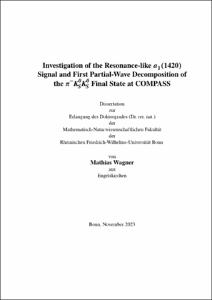Investigation of the Resonance-like a1(1420) Signal and First Partial-Wave Decomposition of the π -KS0KS0 Final State at COMPASS

Investigation of the Resonance-like a1(1420) Signal and First Partial-Wave Decomposition of the π -KS0KS0 Final State at COMPASS

| dc.contributor.advisor | Ketzer, Bernhard | |
| dc.contributor.author | Wagner, Mathias | |
| dc.date.accessioned | 2024-04-26T09:07:41Z | |
| dc.date.available | 2024-04-26T09:07:41Z | |
| dc.date.issued | 26.04.2024 | |
| dc.identifier.uri | https://hdl.handle.net/20.500.11811/11513 | |
| dc.description.abstract | In 2014, a supernumerous light-meson state was found by the COMPASS collaboration. This discovery bore similarities to some of the XYZ states in the heavy-meson sector, discovered at In the first part, it is shown how a rescattering of final-state particles can produce such a signal by explicitly performing a projection of a K*K intermediate state to the f0(980)π final state. The resulting theoretical model is fitted to the COMPASS data and the quality is compared to a fit using a conventional relativistic Breit-Wigner model. Several systematic studies are performed. This includes a fit to each of the systematic studies of the underlying partial-wave decomposition, as well as a bootstrap analysis and modifications of the theoretical model. In all cases except one, the rescattering interpretation shows a better compatibility with the data. In the second part, an event selection of the complementary | en |
| dc.language.iso | eng | |
| dc.rights | Namensnennung 4.0 International | |
| dc.rights.uri | http://creativecommons.org/licenses/by/4.0/ | |
| dc.subject | COMPASS | |
| dc.subject | a1(1420) | |
| dc.subject | pi1(1600) | |
| dc.subject | pi(1800) | |
| dc.subject | exotisch | |
| dc.subject | Meson | |
| dc.subject | Spektroskopie | |
| dc.subject | Dreiecksdiagramm | |
| dc.subject | Dreiecksamplitude | |
| dc.subject | Singularität | |
| dc.subject | Kshort | |
| dc.subject | Kaon | |
| dc.subject | diffractive Streuung | |
| dc.subject | Partialwellenprojektion | |
| dc.subject | komplexe Analysis | |
| dc.subject | Ereignisselektion | |
| dc.subject | Partialwellenanalyse | |
| dc.subject | Partialwellenzerlegung | |
| dc.subject | Resonanzmodell | |
| dc.subject | exotic | |
| dc.subject | spectroscopy | |
| dc.subject | rescattering | |
| dc.subject | triangle diagram | |
| dc.subject | triangle amplitude | |
| dc.subject | singularity | |
| dc.subject | diffractive scattering | |
| dc.subject | partial-wave projection | |
| dc.subject | complex analysis | |
| dc.subject | event selection | |
| dc.subject | partial-wave analysis | |
| dc.subject | partial-wave decomposition | |
| dc.subject | resonance model | |
| dc.subject.ddc | 530 Physik | |
| dc.title | Investigation of the Resonance-like a1(1420) Signal and First Partial-Wave Decomposition of the | |
| dc.type | Dissertation oder Habilitation | |
| dc.identifier.doi | https://doi.org/10.48565/bonndoc-273 | |
| dc.publisher.name | Universitäts- und Landesbibliothek Bonn | |
| dc.publisher.location | Bonn | |
| dc.rights.accessRights | openAccess | |
| dc.identifier.urn | https://nbn-resolving.org/urn:nbn:de:hbz:5-75936 | |
| ulbbn.pubtype | Erstveröffentlichung | |
| ulbbnediss.affiliation.name | Rheinische Friedrich-Wilhelms-Universität Bonn | |
| ulbbnediss.affiliation.location | Bonn | |
| ulbbnediss.thesis.level | Dissertation | |
| ulbbnediss.dissID | 7593 | |
| ulbbnediss.date.accepted | 22.03.2024 | |
| ulbbnediss.institute | Mathematisch-Naturwissenschaftliche Fakultät : Fachgruppe Physik/Astronomie / Helmholtz-Institut für Strahlen- und Kernphysik (HISKP) | |
| ulbbnediss.fakultaet | Mathematisch-Naturwissenschaftliche Fakultät | |
| dc.contributor.coReferee | Schmieden, Hartmut | |
| ulbbnediss.contributor.orcid | https://orcid.org/0009-0008-9874-4265 |
Files in this item
This item appears in the following Collection(s)
-
E-Dissertationen (4442)




